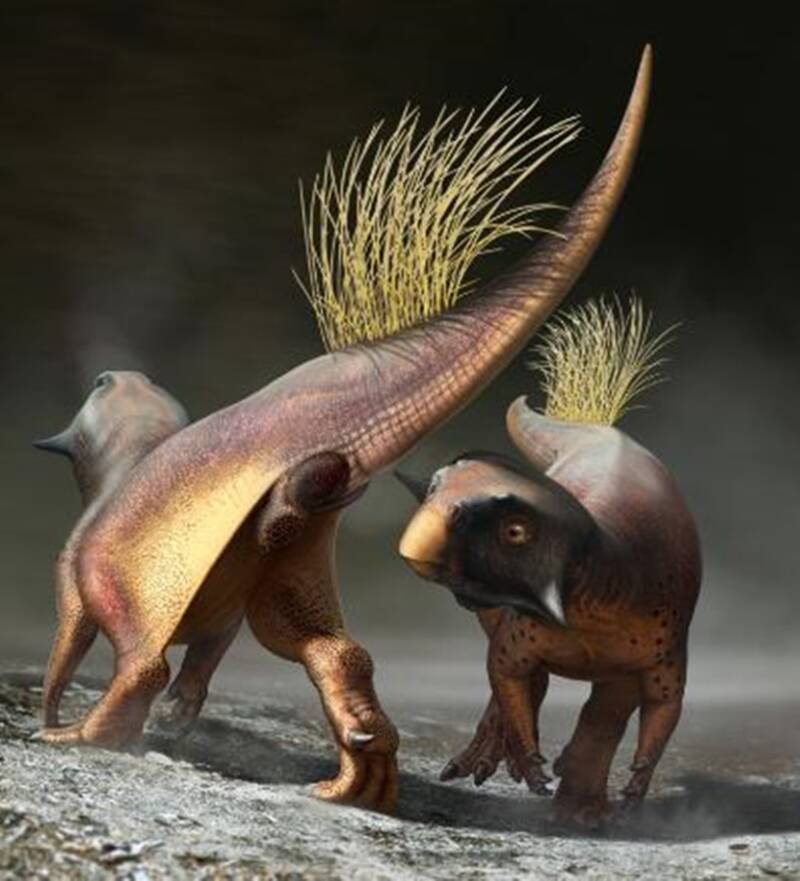Paleontologists said this dinosaur had a one-of-a-kind opening that was “shaped in its perfect, unique way.”

Vinther et alThis well-preserved Psittacosaurus fossil from China enabled scientists to study a dinosaur cloaca for the first time.
A unique fossil has revealed how dinosaurs may have peed, pooped, and had sex. And it all comes down to one multipurpose hole.
According to CNN, an extremely well-preserved Psittacosaurus fossil from China has enabled scientists to examine the mysterious orifice that the dinosaurs used for multiple bodily functions. Despite being more than 100 million years old, the orifice was stunningly well-preserved.
Although most mammals have separate holes to serve different bodily functions — such as defecating and urinating — other animals like birds and reptiles only use one orifice called the cloaca.
This fossil confirms that dinosaurs once had a cloaca as well. However, a new study of the Psittacosaurus fossil showed that the cloaca of dinosaurs was unlike that of any living animal on this Earth today. The authors of the study described the dinosaur orifice as “very unique.”
“Most cloacas form a kind of slit. Sometimes it’s a vertical split, sometimes it’s a smiley face, sometimes it’s a sour face,” said Jakob Vinther, a paleontologist and senior lecturer at the University of Bristol’s School of Earth Sciences. “This thing has a V-shaped structure with a pair of nice flaring lips and there’s not a living group of animals that have morphology like that.”

Bob Nicholls/Paleocreations.comAn artist’s illustration of a Psittacosaurus attracting a mate using its cloaca glands.
The Psittacosaurus is a genus of ceratopsian dinosaur that lived in the Early Cretaceous period, between 126 and 101 million years ago, in what is now Asia.
The fossil was initially discovered decades ago in the fossil-rich province of Liaoning in northern China. Vinther began work on the fossil in 2016 in an attempt to reconstruct the color pattern of the dinosaur. But as he reached the final stages of his first study, he realized that the dinosaur’s cloaca was intact enough that it could possibly be examined as well.
“I got a chance to look at the specimen again, up close, and suddenly realized, ‘Oh my God, the cloaca is actually quite well preserved, and we can actually see some anatomy that I didn’t think we could see,’” Vinther recalled. He teamed up with Diane Kelly, an expert on vertebrate penises and copulatory systems from the University of Massachusetts Amherst, and paleoartist Robert Nicholls to do research on the orifice.
The study, which was published in the journal Current Biology in January 2021, was the first of its kind.
The team made a number of intriguing discoveries. For one, they noted that the orifice was flanked by large, pigmented lobes on both sides of the opening, which the researchers believe could have held musky scent glands, similar to what we see in living crocodiles.

Vinther et alAnimals with cloacal vents typically have their genitals tucked inside their bodies.
The authors also suggested that the exterior of the orifice may have acted as a signal for courtship with potential mates. The outer section of the cloaca appeared highly pigmented with melanin, though it’s unclear what its exact coloring was.
It was likely a different shade than the dinosaur’s pale underbelly, which could help attract potential mates. This “display” could have been similar to what we see among baboons and some species of salamander today.
Researchers also theorized how the cloaca was used by the dinosaur by looking at the animal’s closest living relatives: birds.
Most bird species mate by “cloacal kissing,” in which the mates press their cloacal openings together. While some paleontologists believe dinosaurs also mated like this, Vinther and his team now think otherwise.
“From what we can see, this cloaca would not have been suitable for cloacal kissing,” Vinther said. “It looks like it would have been penetrative sex.”
Vinther and his team also believe this dinosaur may have had a penis, because the cloaca was somewhat similar to one of a male crocodile — which does have that genital organ.
But it is worth noting that when animals have a cloaca, their genitals are typically tucked inside the body. Since none of the reproductive tissues were preserved in this fossil, it’s hard to tell whether the dinosaur was male or female. Still, Vinther is convinced that the animal mated in a penetrative way.
The fossil is now displayed at the Senckenberg Museum of Natural History in Frankfurt, Germany.